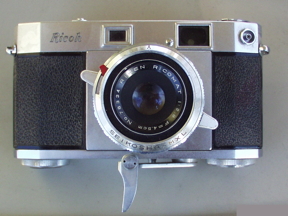Ricoh 500 on:
[Wikipedia]
[Google]
[Amazon]
 The Ricoh 500 was one of the early relatively inexpensive 35 mm
The Ricoh 500 was one of the early relatively inexpensive 35 mm
File: Ricoh 500 top.jpg, Top view
File: Ricoh 500 bottom.jpg, Bottom view
 The Ricoh 500 was one of the early relatively inexpensive 35 mm
The Ricoh 500 was one of the early relatively inexpensive 35 mm rangefinder camera
A rangefinder camera is a camera fitted with a rangefinder, typically a split-image rangefinder: a range-finding focusing mechanism allowing the photographer to measure the subject distance and take photographs that are in sharp focus. Most va ...
s to enter the U.S. market in 1957.collectiblend.com/Cameras/Riken/Ricoh-500.html It had an unusually large (for that time) f/2.8 lens
A lens is a transmissive optical device which focuses or disperses a light beam by means of refraction. A simple lens consists of a single piece of transparent material, while a compound lens consists of several simple lenses (''elements ...
, and shutter speeds from 1 second to 1/500 second. Film
A film also called a movie, motion picture, moving picture, picture, photoplay or (slang) flick is a work of visual art that simulates experiences and otherwise communicates ideas, stories, perceptions, feelings, beauty, or atmospher ...
was advanced by a rapid-throw "trigger" mechanism on the bottom, and focus
Focus, or its plural form foci may refer to:
Arts
* Focus or Focus Festival, former name of the Adelaide Fringe arts festival in South Australia Film
*''Focus'', a 1962 TV film starring James Whitmore
* ''Focus'' (2001 film), a 2001 film based ...
was controlled by two buttons, at the 3 o'clock and 9 o'clock positions that permitted very rapid shifts of focus when needed for basketball and other such sporting events. Flash could be fired from a "hot shoe" on the top and from a regular socket connection.
The photograph above shows the external flash connection socket in the upper right corner. The red lever selects among M, F, and X flash synchronization
In photography, flash synchronization or flash sync is the synchronizing the firing of a photographic flash with the opening of the shutter admitting light to photographic film or electronic image sensor.
In cameras with mechanical (clockwor ...
s. The shutter button is barely visible over the letter "h" of "Ricoh." The two large knobs are designed to let the user's two index fingers rapidly focus the camera while following basketball players or other rapidly moving subjects. The wired mount for an external flash unit is shown in the center of the top view of the camera. The rapid film advance lever shown in the bottom view pivots on its right end and is pulled by the extension (shown folded out of the way) near the lens barrel. The bottom view also shows a reminder ring for noting the speed
In everyday use and in kinematics, the speed (commonly referred to as ''v'') of an object is the magnitude of the change of its position over time or the magnitude of the change of its position per unit of time; it is thus a scalar quant ...
of the film currently in use.
The Riken Ricomat lens had a focal length of 4.5 cm. The Seikosha shutter had provision for "m," "x," and "l" synchronization.
The rings controlling the effective lens diameter (from f/2.8 to f/22) and the shutter speed are mechanically linked so that once one combination has been matched to the ambient lighting conditions, a faster shutter speed can be selected and a larger effective lens diameter will automatically be set when possible. For instance, one might start with a setting of f/11 and 1/250 second, but decide that the moving target demanded the higher shutter speed of 1/500. Simply setting that shutter speed without changing the effective lens aperture would result in an underexposure, but the Ricoh 500 will automatically change the aperture setting to f/8.
References
External links
*http://classiccameras-photography.blogspot.com/2011/01/ricoh-500.html *http://www.collection-appareils.fr/ricoh/html/ricoh500.php *http://wkoopmans.ca/notebook/?p=2088 Ricoh rangefinder cameras {{camera-stub